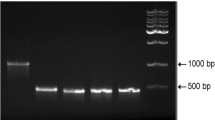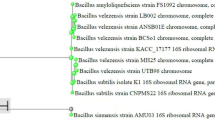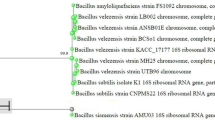Abstract
In the wake of an increased attention on the eco-friendly biopesticidal products and the rising market requirements for organic agents, lipopeptides compounds have been described as biological control agents which improve the overall health growth and development of plants. Nevertheless, their high production cost constitue the major flaw in their wide use to control plant diseases. The present article aims to formulate an economic media for lipopeptides production by Bacillus mojavensis A21 for application as natural fungicides for plant disease treatment. We herein demonstrated the suitability of the potato waste, as low cost substrate, for lipopeptides production. Moreover, sea water was found to be a good mineral salts sources. In the second part of this study, we investigate the inhibitory activity of A21 lipopeptides against the phtopathogenic Fusarium sp. The in vitro test showed a minimal inhibitory concentration of about 0.3 mg/ml. The microscopic examination, of the treated Fusarium revealed an excessive lysis of the mycelia ultrastructure with destructed spores. The in vivo antagonist activity was confirmed towards the infected potato tubers. A21 lipopeptides are effective in decreasing by about 78.26% and 60.68% when applied as preventive and curative treatments, respectively, as compared to the untreated tubers.










Similar content being viewed by others
References
Abalos A, Pinazo A, Infante MR, Casals M, García F, Manresa A (2001) Physicochemical and antimicrobial properties of new rhamnolipids produced by Pseudomonas aeruginosa AT10 from soybean oil refinery wastes. Langmuir 17:1367–1371
Agarry SE, Salam KK, Arinkoola A, Aremu MO (2015) biosurfactant production by indigenous Pseudomonas and Bacillus species isolated from auto mechanic sol environment towards microbial enhanced oil recovery. Eur J Eng Technol 3(6)
Barros FFC, Quadros CP, Maróstica MR, Pastore GM (2007) Surfactina: Propriedades químicas, tecnológicas e funcionais para aplicações em alimentos. Quim Nova 30:01–14
Ben Ayed H, Hmidet N, Béchet M, Chollet M, Chataigné G, Leclère V, Jacques P, Nasri M (2014) Identification and biochemical characteristics of lipopeptides from Bacillus mojavensis A21. Process Biochem 49:1699–1707
Bonmatin JM, Laprévote O, Peypoux F (2003) Diversity among microbial cyclic lipopeptides: iturins and surfactins. Activity-structure relationships to design new bioactive agents. Comb Chem High Throughput Screen. 6:541–556
Cao Y, Xu Z, Ling N, Yuan Y, Yang X, Chen L, Shen B, Shen Q (2012) Isolation and identification of lipopeptides produced by B. subtilis SQR 9 for suppressing Fusarium wilt of cucumber. Sci Hortic 135:32–39
Chandler J (2005) Cost reduction in SIT programmes using exosect auto-dissemination as part of area wide integrated pest management. Int Jof Pest Control 47:257–260
Chitarra GS, Breeuwer P, Nout MJR, van Aelst AC, Rombouts FM, Abee T (2003) An antifungal compound produced by Bacillus subtilis YM 10–20 inhibits germination of Penicillium roqueforti conidiospores. J Appl Microbiol 94:159–166
Coutte F, Lecouturier D, Yahia SA, Leclère V, Béchet M, Jacques P et al (2010) Production of surfactin and fengycin by Bacillus subtilis in a bubbleless membrane bioreactor. Appl Microbiol Biotechnol 87:499–507
Cowen LE, Sanglard D, Howard SJ, Rogers PD, Perlin DS (2015) Mechanisms of antifungal drug resistance. Cold Spring Harb Perspect Med 5:a019752
Das K, Tiwari RK, Shrivastava DK (2010) Techniques for evaluation of medicinal plant products as antimicrobial agent: current methods and future trends. J Med Plants Res 4:104–111
Deleu M, Razafindralambo H, Popineau Y, Jacques P, Thonart P, Paquot M (1999) Inter-facial and emulsifying properties of lipopeptides from Bacillus subtilis. Colloid Surf A 152:3–10
Des Grades ZE, der Agrarwissenschaften D, Fakultät HL, Wilhelms RF (2012) Biological control of leaf pathogens of tomato plants by Bacillus subtilis (strain FZB24): antagonistic effects and induced plant resistance. Inaugural-Dissertation, Institute of Crop Science and Resource Conservation—Phytomedicine, vorgelegt am 06.06.201
Etchegaray A, de Castro Bueno C, de Melo IS, Tsai SM, de Fátima Fiore MF, Silva-Stenico ME, de Moraes LAB, Teschke O (2008) Effect of a highly concentrated lipopeptide extract of Bacillus subtilis on fungal and bacterial cells. Arch Microbiol 190:611–622
Fox SL, Bala G (2000) Production of surfactant from Bacillus subtilis ATCC 21332 using potato substrates. Biores Technol 75:235–240
Fravel DR (2005) Commercialization and implementation of biocontrol. Annu Rev Phytopathol 43:337–359
Galvano F, Piva A, Ritienei A, Galvano G (2001) Dietary strategies to counteract the effect of mycotoxins: a review. J Food Prot 64:120–131
Gancel F, Montastruc L, Liu T, Zhao L, Nikov I (2009) Lipopeptide overproduction by cell immobilization on iron-enriched light polymer particles. Process Biochem 44:975–978
Gupta PK (2011) Herbicides and fungicides in reproductive and developmental toxicology
Gurjar J, Sengupta B (2015) Production of surfactin from rice mill polishing residue by submerged fermentation using Bacillus subtilis MTCC 2423. Bioresour Technol 189:243–249
Haddar A, Bougatef A, Agrebi R, Sellami-Kamoun A, Nasri M (2009) A novel surfactant stable alkaline-serine from a newly isolated Bacillus mojavensis A21: purification and characterization. Process Biochem 44:29–35
Hammami I, Triki MA, Rebai A (2011) Purification and characterization of the novel bacteriocin Back IH7 with antifungal and antibacterial properties. J Plant Pathol 93:443–454
Janardhana GR, Raveesha KA, Shetty HS (1999) Mycotoxin contamination of maize grains grown in Karnataka (India). Food Chem Toxicol 37:863–868
Joshi R, McSpadden Gardener BB (2006) Identification and characterization of novel genetic markers associated with biological control activities in Bacillus subtilis. Phytopathology 96:145–154
Kita N, Ohya T, Uekusa H, Nomura K, Manago M, Shoda M (2005) Biological control of damping-off of tomato seedlings and cucumber Phomopsis root rot by Bacillus subtilis RB14-C. Jpn Agric Res Q 39:109–114
Leclère V, Béchet M, Adam A, Guez JS, Wathelet B, Ongena M, Thonart P, Gancel F, Chollet-Imbert M, Jacques P (2005) Mycosubtilin overproduction by Bacillus subtilis BBG100 enhances the organism’s antagonistic and biocontrol activities. Appl Environ Microbiol 71:4577–4584
Leelasuphakul W, Hemmanee P, Chuenchitt S (2008) Growth inhibitory properties of Bacillus subtilis strains and their metabolites against the green mold pathogen (Penicillium digitatum Sacc.) of citrus fruit Postharvest. Biol Technol 48:113–121
Li L, Ma MC, Huang R, Qu Q, Li GH, Zhou JW, Zhang KQ, Lu KP, Niu XM, Luo J (2012) Induction of chlamydospore formation in fusarium by cyclic lipopeptide antibiotics from Bacillus subtilis C2. J Chem Ecol 38:966–974
Lin HF, Chen TH, Liu SD (2010) Bioactivity of antifungal substance iturin A produced by Bacillus subtilis strain BS-99-H against Pestalotiopsis eugeniae, a causal pathogen of wax apple fruit rot. Plant Pathol Bull 19:225–233
Makkar RS, Cameotra SS (2002) An update on the use of unconventional substrates for biosurfactant production and their new applications. Appl Microbiol Biotechnol 58:428–434
Matar SM, Kazzaz SAE, Wagih EE, El-Diwany AI, Moustafa HE (2009) Bioprocessing and scaling-up cultivation of Bacillus subtilis as a potential antagonist to certain plant pathogenic fungi. Biotech 8:138–143
Meena KR, Kanwar SS (2015) Lipopeptides as the antifungal and antibacterial agents: applications in food safety and therapeutics. Biomed Res Int. https://doi.org/10.1155/2015/473050
Miller JD (1995) Fungi and mycotoxins in grain: implications for stored product research. J Stored Prod Res 31:1–16
Mnif I, Hammami I, Triki MA, Cheffi Azabou M, Ellouze-Chaabouni S, Ghribi D (2015) Antifungal efficiency of a lipopeptide biosurfactant derived from Bacillus subtilis SPB1 versus the phytopathogenic fungus, Fusarium solani. Environ Sci Pollut Res 22:18137–18147
Noah KS, Bruhn DF, Bala GA (2005) Surfactin production from potato process efluent by Bacillus subtilis in a chemostat. App biochem biotechnol 122:465–474
Ongena M, Jacques P (2008) Bacillus lipopeptides: versatile weapons for plant disease biocontrol. Trends Microbiol 16:115–125
Ongena M, Jourdan E, Adam A, Paquot M, Brans A, Joris B, Arpigny JL, Thonart P (2007) Surfactin and fengycin lipopeptides of Bacillus subtilis as elicitors of induced systemic resistance in plants. Environ Microbiol 9:1084–1090
Rebib H, Hedi A, Rousset M, Boudabous A, Limam F, Sadfi-Zouaoui N (2012) Biological control of Fusarium foot rot of wheat using fengycin-producing Bacillus subtilis isolated from salty soil. Afr J Biotechnol 11:8464–8475
Romero D, de Vicente A, Rakotoalay RH, Dufour SE, Veening JW, Arrebola A, Cazorla FM, Kuipers OP, Paquot M, Pérez García A (2007) The iturin and fengycin families of lipopeptides are key factors in antagonism of Bacillus subtilis toward Podosphaera fusca. Mol Plant-Microbe Interact 20:430–440
Ruangwong OU, Chang CI, Lamine SA, Liang WJ (2012) Identification of antifungal compound produced by Bacillus subtilis LB5 with ability to control anthracnose disease caused by Colletotrichum gloeosporioides. Afr J Microbiol Res 6:3732–3738
Sharma D, Ansari MJ, Gupta S, Al Ghamdi A, Pruthi P, Pruthi V (2015a) Structural characterization and antimicrobial activity of a biosurfactant obtained from Bacillus pumilus DSVP18 grown on potato peels Jundishapur. J Microbiol. https://doi.org/10.5812/jjm.21257
Sharma R, Rani D, Jain N, Katwa SM, Jaitawat A (2015b) Healthy pregnancy with potato: a review. Int J Curr Res Biosci Plant Biol 2:35–46
Straus SK, Hancock REW (2006) Mode of action of the new antibiotic for Gram-positive pathogens daptomycin: comparison with cationic antimicrobial peptides and lipopeptides. Biochim Biophys Acta Biomembr 1758:215–1223
Suprapta DN (2012) Potential of microbial antagonists as biocontrol agents against plant fungal pathogens. J ISSAAS 18:1–8
Surekha K, Satpute Grażyna A, Płaza Arun GB (2017) Biosurfactants’ production from renewable natural resources: example of innovative and smart technology in circular bioeconomy. Manag Syst Prod Eng 25:46–54
Tawara S, Ikeda F, Maki K, Morishita Y et al (2000) In vitro activities of a new lipopeptide antifungal agent, FK463, against a variety of clinically important fungi. Antimicrob Agents Chemother 44:57–62
Thompson DN, Fox SL, Bala GA (2000) Biosurfactants from potato process effluents. Appl Biochem Biotechnol 84–86:917–930
Yangui T, Sayadi S, Dhouib A (2013) Sensitivity of Pectobacteriu mcarotovorum to hydroxytyrosol-rich extracts and their effect on the development of soft rot in potato tubers during storage. Crop Prot 53:52–57
Yokota K, Hayakawa H (2015) Impact of antimicrobial lipopeptides from Bacillus sp. on suppression of Fusarium yellows of tatsoi. Microbes Environ 30:281–283
Zeriouh H, Romero D, García-Gutiérrez L, Cazorla FM, de Vicente A, García A (2011) The iturin-like lipopeptides are essential components in the biological control arsenal of Bacillus subtilis against bacterial diseases of cucurbits. Am Phytopathol Soc 24:1540–1552
Zhang SM, Wang YX, Meng LQ, Li J et al (2012) Isolation and characterization of antifungal lipopeptides produced by endophytic Bacillus amyloliquefaciens TF28. Afr J Microbiol Res 6:1747–1755
Zouari R, Ellouze-Chaabouni S, Ghribi-Aydi D (2015) Optimization of Bacillus subtilis SPB1 biosurfactant production under solid-state fermentation using by-products of a traditional olive mill factory Ach. Life Sci 8:162–169
Zu W, Yu H, Liang L, Fu Y, Efferth T, Liu X, Wu N (2010) Activities of ten essential oils towards Propionibacterium acnes and PC-3, A-549 and MCF-7 cancer cells. Molecules 15:3200–3210
Funding
This work has been supported by grants from the Tunisian Ministry of Higher Education, Scientific Research and Technology and the Tunisian Ministry of Agriculture.
Author information
Authors and Affiliations
Corresponding author
Rights and permissions
About this article
Cite this article
Ayed, H.B., Azabou, M.C., Hmidet, N. et al. Economic production and biocontrol efficiency of lipopeptide biosurfactants from Bacillus mojavenis A21. Biodegradation 30, 273–286 (2019). https://doi.org/10.1007/s10532-018-9864-7
Received:
Accepted:
Published:
Issue Date:
DOI: https://doi.org/10.1007/s10532-018-9864-7




